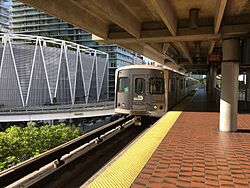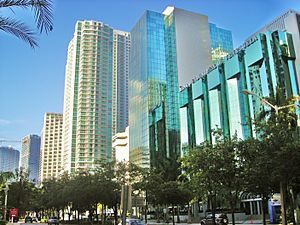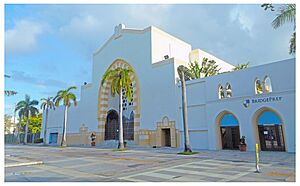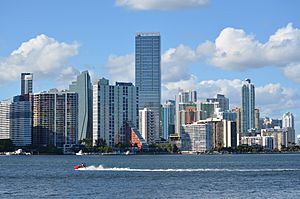Greater Downtown Miami facts for kids
Quick facts for kids
Downtown Miami
|
|
|---|---|
|
Neighborhood
|
|
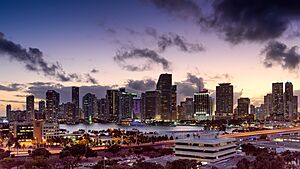
Downtown Miami skyline in 2019
|
|
| Nicknames:
Downtown, Central Business District
|
|
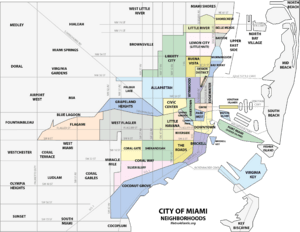
Downtown neighborhoods within the City of Miami
|
|
| Country | United States |
| State | Florida |
| County | Miami-Dade County |
| City | Miami |
| Settled | 1830s |
| Incorporated into the City of Miami | 1896 |
| Subdistricts of Downtown |
Neighborhoods
Brickell
Central Business District (CBD) Downtown Miami Historic District Edgewater Jewelry District Midtown Arts & Entertainment District Overtown Park West Wynwood |
| Area | |
| • All Downtown neighborhoods | 3.80 sq mi (9.84 km2) |
| Population
(2010)
|
|
| • All Downtown neighborhoods | 66,769 |
| • Density | 17,570/sq mi (6,780/km2) |
| • CBD population only | 13,856 |
| • Daytime population | 250,757 |
| Demonym(s) | Downtowner |
| Time zone | UTC-05 (EST) |
| ZIP Code |
33128, 33129, 33130, 33131, 33132, 33136
|
| Area code(s) | 305, 786 |
Downtown Miami is the busy city center of Miami, Florida, in the United States. It's a big area that includes several neighborhoods. These are the Central Business District, Brickell, the Historic District, Government Center, the Arts & Entertainment District, and Park West. The Miami River divides Downtown Miami.
This area is the heart of the Miami metropolitan area. This is the ninth-largest city area in the U.S. and the 34th-largest in the world. About 6.158 million people live here.
In Downtown Miami, Brickell Avenue and Biscayne Boulevard are the main north-south roads. Flagler Street is the main east-west road. Downtown Miami is known as a center for culture, money, and business. Its history goes back to the 1800s. Today, Downtown Miami has many tall buildings, museums, parks, and shops. It also has some of the city's oldest buildings.
Contents
- History of Downtown Miami
- Neighborhoods of Downtown Miami
- Who Lives in Downtown Miami?
- Getting Around Downtown Miami
- Economy and Businesses
- Historic Places in Downtown Miami
- Parks and Green Spaces
- Cost of Living in Downtown Miami
- Shopping in Downtown Miami
- Education in Downtown Miami
- Cultural Spots
- Downtown Miami's Tall Buildings
- See also
History of Downtown Miami
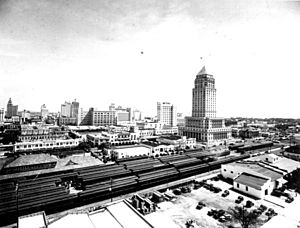
Downtown Miami is the oldest part of Miami. People started settling here in the early 1800s. The city began to grow in the 1890s. This was when Henry Flagler built the Florida East Coast Railway to Miami. Julia Tuttle convinced him to do it.
Flagler and other developers like William Brickell helped Miami grow. They built hotels, resorts, and homes. Flagler Street in Downtown is named after Henry Flagler. The Julia Tuttle Causeway is named after Julia Tuttle.
In 2009, about 71,000 people lived in Greater Downtown year-round. This includes the Brickell, Park West, and Arts & Entertainment District neighborhoods. During the day, nearly 200,000 people are in the Downtown area. This makes it one of the busiest downtowns in the U.S.
Downtown has grown a lot with new tall buildings. Many new shops, bars, and restaurants have opened. This has attracted many new residents. From 2000 to 2009, Downtown and Brickell grew from 40,000 to over 70,000 residents. About 550 new people moved to Downtown every month in 2010.
Neighborhoods of Downtown Miami
Downtown Miami is built around the Central Business District (CBD). Locals often just call it "Downtown." Even though they are different, all these areas are part of "Downtown Miami":
Central Business District (CBD)

The Central Business District (CBD) is the historic heart of Miami. It is bordered by Northeast Sixth Street to the north and Biscayne Bay to the east. The Miami River forms its western and southern borders.
Most of Miami's old buildings are here. This includes Flagler Street, museums, and libraries. Many government offices and courthouses are also in this district. The Historic District and Government Center are here too.
The CBD has its own train stations. You can use Miami Metrorail at Government Center Station. There are also 13 Metromover stations on different loops.
Miami Jewelry District
The Miami Jewelry District is a special part of the Central Business District. It is famous for its many jewelry stores and gem dealers. You can find all kinds of jewelry here. It's one of only three jewelry districts in the United States.
This district covers four city blocks. It is between North Miami Avenue, Northeast Second Avenue, East Flagler Street, and Northeast Second Streets. You can buy designer jewelry, precious stones, and gold and silver items. You can reach the Jewelry District by Metromover and Metrorail.
Brickell: Miami's Financial Hub
Brickell is located south of the Miami River. It is a fancy residential area. It's also Miami's main financial district. Many banks and businesses are along Brickell Avenue.
Places like The Shops at Mary Brickell Village and Brickell City Center are in Brickell. You can get to Brickell by Miami Metrorail at Brickell Station. There are also five Metromover stations on the Brickell Loop.
Arts and Entertainment District
The Arts & Entertainment District is a city neighborhood. It has many hotels and tall apartment buildings. Its old name, Omni, came from the Omni International Mall. This mall is on Biscayne Boulevard.
The district is next to Biscayne Bay on the east. It borders NE 2nd Ave to the west. NE 21st St is to the north, and I-395 is to the south. The Adrienne Arsht Center for the Performing Arts is here. The Arts & Entertainment District is served by the Miami Metrorail at Government Center Station. It also has two Metromover stations on the Omni Loop.
Park West
Park West is west of Museum Park. It is east of NW 1st Ave. It is south of I-195 and north of NE 6th St. This area was once known for its nightclubs.
Recently, many nightclubs were torn down. This makes way for new projects like Miami World Center. Park West is served by the Miami Metrorail at Historic Overtown/Lyric Theatre Station. It also has three Metromover stations on the Omni Loop.
Who Lives in Downtown Miami?
| Historical population | |||
|---|---|---|---|
| Census | Pop. | %± | |
| 1990 | 36,140 | — | |
| 2000 | 40,556 | 12.2% | |
| 2010 | 66,769 | 64.6% | |
| 2020 | 110,006 | 64.8% | |
| 2022 (est.) | 113,649 | 70.2% | |
| source: | |||
In 2010, Downtown Miami had 65,696 people. This means there were about 27,487 people per square mile. The population has grown a lot since then.
In 2010, the people living in Downtown were:
- 57.6% Hispanic
- 30.8% White (non-Hispanic)
- 7.2% Black
- 2.9% Asian
The average household size in 2009 was 2.0 people. Many people who live in Downtown rent their homes. About 550 new residents move to Downtown every month.
Getting Around Downtown Miami
Public transportation is very important in Downtown Miami. People use it more here than in other parts of Miami.
The Miami Metrorail is Miami's main train system. It has three stops in Downtown:
- Historic Overtown/Lyric Theatre Station
- Government Center Station
- Brickell Station
The Metrorail connects to Miami International Airport. It also connects to all Metrobus lines and Tri-Rail.
The Metromover is a free, automated train system. It runs three lines: the Downtown Loop, the Omni Loop, and the Brickell Loop. There are 22 stations throughout Downtown. Metromover stations are about two blocks apart. It's a great way to get around without a car.
Downtown Miami is a very pedestrian-friendly area. Many residents walk, bike, or use public transit. The city is adding more bike lanes and bike parking. This makes bicycling more popular. The Venetian Causeway is a popular bike route to South Beach.
Future Train Plans
There are plans to expand the Tri-Rail system. This commuter train might add service along the Florida East Coast Railway (FEC) corridor. This would connect Downtown directly to other neighborhoods like Midtown Miami and Fort Lauderdale.
Taxis in Downtown
Taxis are also popular in Downtown. Many residents don't own cars. Taxis are useful for rides within Downtown or to other areas like South Beach. You can hail a taxi on the street or call for one.
Economy and Businesses
Downtown Miami is home to many companies and organizations. It has about 20 million square feet of office space. It is the main financial and business center of South Florida.
Many private companies have their main offices here. These include Akerman LLP, Arquitectonica, and Greenberg Traurig. The Miami Herald newspaper is also based here.
Government offices are also in Downtown. These include Miami-Dade County government and Miami-Dade County Public Schools. The Miami Police Department also has its main offices here.
International Consulates
Many countries have consulates in Downtown. These are like small embassies that help citizens from their home country. Most are on Biscayne Boulevard and Brickell Avenue.
Some countries with consulates here include:
Chambers of Commerce
Downtown also has many international chambers of commerce. These groups help businesses from different countries work together. Examples include the British American Business Council and the Italy-America Chamber of Commerce.
Historic Places in Downtown Miami

Downtown Miami has three U.S. historic districts. These are special areas with old buildings that are protected. They are the Downtown Miami Commercial Historic District, the Downtown Miami Historic District, and the Lummus Park Historic District.
The Downtown Miami Historic District covers 380 acres. It has over 60 buildings. Many of these buildings were built between 1900 and 1949. They show styles like Moderne and Classical Revival.
The Lummus Park Historic District is west of Downtown. It is near Lummus Park along the Miami River. This district has 43 buildings. They show styles like Art Deco and Bungalow.
Parks and Green Spaces

Downtown's biggest and most popular parks are Bayfront Park, Museum Park, and Pace Park.
- Bayfront Park hosts free concerts and many annual events. These include the Orange Drop for New Year's and the "America's Birthday Bash" for Independence Day. It also hosts large outdoor concerts like Ultra Music Festival.
- Museum Park used to be Bicentennial Park. It has been rebuilt and is now home to the Pérez Art Museum Miami and the Phillip and Patricia Frost Museum of Science.
Other parks in Downtown include:
- Fort Dallas Park
- Lummus Park
- Paul S. Walker Park
- Simpson Park
- Alice Wainwright Park
- Miami Circle
Cost of Living in Downtown Miami
In 2010, the average apartment sale price was $347,729. This was up 15% from 2009. During a building boom in the early 2000s, over 23,000 apartments were built. More than 85% of these apartments are now lived in.
Downtown has over 6,000 hotel rooms. It has the most hotel rooms in Miami. It is a main hub for business travelers. Many hotels are for business, but some are luxury hotels or budget-friendly options.
Shopping in Downtown Miami
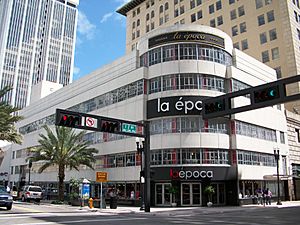
Historically, Flagler Street has been Downtown's main shopping street. It has been important since the 1800s. Today, it still has many shops. It used to have Florida's main Macy's store. Many old and famous jewelers are also on Flagler Street. This area is called the Miami Jewelry District.
Efforts have been made to make Flagler Street even better. New restaurants and stores have opened. There are new green spaces and art. Three new small parks opened on Flagler Street in 2009.
Besides Flagler Street, Downtown has two other major shopping areas:
- Bayside Marketplace: Built in 1987, it's a popular outdoor mall. It overlooks Biscayne Bay at Bayfront Park. It gets over 15 million visitors each year.
- Mary Brickell Village: This is in Brickell. It's a popular nightlife spot with many fancy bars and restaurants.
Education in Downtown Miami
Public Schools
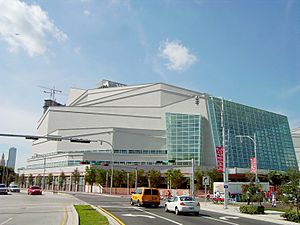

Miami-Dade County Public Schools runs the public schools in Downtown Miami.
Elementary Schools
- Downtown Miami Charter School
- Southside Elementary School
- Miami Children's Museum School
- Bridgepoint Academy of Greater Miami (Charter)
High Schools
- Law Enforcement Officers' Memorial High School (a special magnet school)
- New World School of the Arts (an arts magnet school)
Public School Zones
Children in Downtown are assigned schools based on where they live. This is usually split into Brickell, Central Business District (CBD), and Arts & Entertainment District/Edgewater.
- Elementary schools: Southside Elementary (for Brickell), Riverside Elementary (for CBD), Frederick Douglass Elementary (for CBD), Phillis Wheatley Elementary (for Arts & Entertainment District and Edgewater).
- Middle schools: Shenandoah Middle School (for Brickell), José de Diego Middle School (for CBD, Arts & Entertainment District and Edgewater).
- High schools: Young Women's Preparatory School (all-girls), Young Men's Preparatory School (all-boys), and Booker T. Washington High School are open to all Downtown residents.
Private Schools
There are plans for a new school in Brickell called "Brickell Preparatory Academy." Other private schools include:
- First Presbyterian International Christian School
- Gordon Day School (Jewish)
- Prima Casa Montessori School
Colleges and Universities
- Florida International University (Downtown Center)
- Miami Dade College (Wolfson Campus)
- Miami International University of Art & Design
- Miami Culinary Institute
- University of Miami (in nearby Coral Gables)
Cultural Spots

Museums and Historic Places
- Pérez Art Museum Miami
- Historical Museum of Southern Florida
- Miami Children's Museum
- Freedom Tower
- City of Miami Cemetery
- Miami Circle
Theaters and Performances
- Adrienne Arsht Center for the Performing Arts (includes Ziff Ballet Opera House and Knight Concert Hall)
- Gusman Center for the Performing Arts
- Miami City Ballet
Libraries
- Miami Main Library
Places of Worship
Downtown Miami has many churches and synagogues, including:
- Central Baptist Church (1925)
- First Presbyterian Church (1898)
- Gesu Catholic Church (1896)
- Temple Israel of Greater Miami (1926)
- Trinity Episcopal Cathedral (1925)
Bookstores and Festivals
- Books and Books – Wachovia Financial Center
- Miami Book Fair International (an annual festival at Miami Dade College)
Fun Events and Festivals
- DWNTWN Concert Series (free concerts at Bayfront Park)
- New Year's Big Orange Drop (Bayfront Park)
- Miami Marathon (in January)
- Ultra Music Festival (electronic music festival in March)
- Miami International Film Festival (in March)
- Independence Day Celebration (Bayfront Park)
- Art Basel Miami (art exhibition in December)
Sports Facilities
- American Airlines Arena, home of the Miami Heat basketball team.
Downtown Miami's Tall Buildings
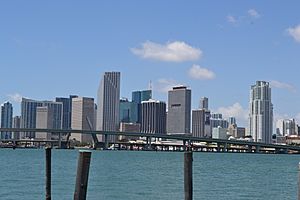
Office Towers
- Four Seasons Hotel Miami
- Southeast Financial Center
- Miami Tower
- One Biscayne Tower
- Brickell Financial Centre
- Dade County Courthouse
- Stephen P. Clark Government Center
Residential Towers
- 900 Biscayne Bay
- Ten Museum Park
- 1800 Club
- Wind
- Marinablue
- One Miami East Tower
- Opera Tower
- Marquis Miami
- 50 Biscayne
Hotel Towers
- Four Seasons Hotel Miami (Brickell)
- Hotel InterContinental
- The Grand Doubletree
See also
 In Spanish: Downtown Miami para niños
In Spanish: Downtown Miami para niños



